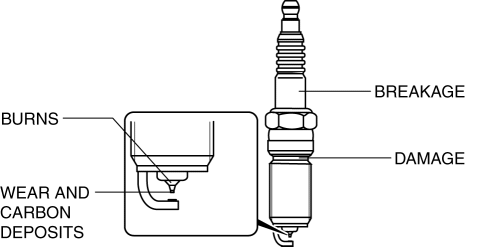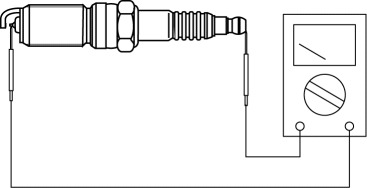Mazda 3 Service Manual: Spark Plug Inspection [Mzr 2.3 Disi Turbo]
Specification
-
Spark plug type
-
L3BD-18110, L3YD-18110
Plug Gap Inspection
CAUTION:
-
To avoid possible damage to the tip, do not adjust the plug gap.
-
To prevent damaging the tip, use a wire type plug gap gauge when inspecting the plug gap.
1. Measure the spark plug gap using a wire type plug gap gauge.
-
If not within the standard specification, replace the spark plug.
-
Spark plug gap
-
Standard: 0.60—0.80 mm {0.024—0.031 in}
-
New spark plug (reference): 0.60—0.70 mm {0.024—0.027 in}
Cleaning
CAUTION:
-
Carbon may adhere to the tip of the spark plug during vehicle delivery or repeated short distance driving during the winter time. If there is any malfunction such as rough idling or start difficulty due to carbon adhesion causing plug fouling, burn off the carbon by performing no-load racing of the engine.
-
When performing the no-load racing, apply the side brake and foot brake, move the shift lever to neutral to prevent an accident and serious injury.
-
To avoid possible damage to the spark plug tip, do not use a wire brush for cleaning.
NOTE:
-
To avoid possible damage to the tip, use gasoline to clean the spark plugs after removing dirt.
-
If the accelerator pedal is depressed continuously for a specified time, the engine speed may decrease to the idle speed. This is due to the PCM control operation, which prevents overheating, and it does not indicate a malfunction.
-
Do not perform no-load racing at high engine speed continuously for 10 s or more
.
1. If there is carbon adhering to the spark plug, perform no-load racing at 4,000 rpm
for 2 min
, 2 times
.
Visual Inspection
1. Inspect the following items:

-
If any of the following malfunctions are indicated, replace the spark plug.
-
Insulator breakage
-
Worn electrode
-
Damaged gasket
-
Badly burned insulator (sparking side)
Resistance Inspection
1. Measure the resistance of the spark plug using a tester as shown in the figure.

-
If not within specification, replace the spark plug.
-
Spark plug resistance [25°C {77 °F}]
-
3.0—7.5 kilohms
 Spark Plug Inspection [Mzr 2.0, Mzr 2.5]
Spark Plug Inspection [Mzr 2.0, Mzr 2.5]
Specification
Spark plug type
LFJD-18110, L3Y2-18110
Plug Gap Inspection
CAUTION:
To avoid possible damage to the tip, do not adjust the spark plug gap. (L3Y2-18110)
To ...
 Spark Plug Inspection [Skyactiv G 2.0]
Spark Plug Inspection [Skyactiv G 2.0]
Specification
Spark plug type
PE01-18110, PE02-18110, PE5R-18110, PE5S-18110
Plug Gap Inspection
CAUTION:
To avoid possible damage to the tip, do not adjust the plug gap.
...
Other materials:
Joint Shaft Disassembly [Mzr 2.0, Mzr 2.5]
1. Disassemble in the order indicated in the table.
1
Joint shaft component
.
2
Bearing
.
3
Dust seal (LH)
4
Joint shaft
5
Dust seal (RH)
...
Electric Variable Valve Timing Actuator Inspection [Skyactiv G 2.0]
WARNING:
A hot engine can cause severe burns. Turn off the engine and wait until it
is cool before servicing.
CAUTION:
Do not disassemble the electric variable valve timing actuator because it
is a precision unit.
1. Remove the battery cover..
2. Disconnect the ne ...
Service Cautions
Injury/damage Prevention Precautions
Depending on the vehicle, the cooling fan may operate suddenly even when
the ignition is switched to off. Therefore, keep hands and tools away from the
cooling fan even if the cooling fan is not operating to prevent injury to personnel
or damage t ...
